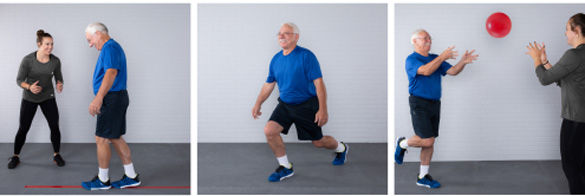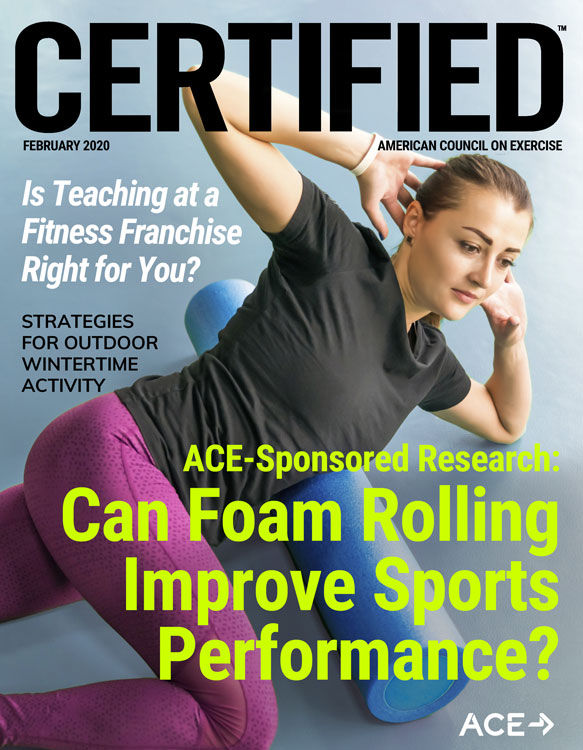
In many regions across the United States, cold temperatures coupled with snow and ice can pose a number of significant challenges to outdoor activity and exercise during wintertime, especially for older adult and clinical populations. Indeed, wintertime environmental conditions place considerable stress on the cardiovascular, respiratory and thermoregulatory systems. For instance, heavy snowfall, cold temperatures and low atmospheric pressure during the winter months have been associated with increased adverse cardiac events (Janardhanan et al., 2010). Additionally, the presence of snow and ice on the ground throughout the winter months increases the risk of slips and falls. This article outlines strategies for helping your clients perform outdoor wintertime activities safely and effectively.
Respiratory System Responses to Activity in Cold Environments
Cold air is commonly dry, and endurance exercise results in a loss of water and heat from the lower respiratory tract (Sue-Chu, 2012). Air must be warmed to body temperature and brought to 100% relative humidity before entering the alveoli. This process, known as conditioning, is done by the respiratory tract, beginning with the nose and mouth. By the time air reaches the trachea it has been warmed to body temperature. This is important as it helps prevent declines in core body temperature. At the same time, air is moistened to 100% humidity before reaching the alveoli. This prevents the cell lining of the passageway from drying out. The burden of the lower respiratory tract to condition the air is much greater for winter outdoor activities when compared to summer outdoor activities (Sue-Chu, 2012). The colder and drier the atmospheric air, the harder the respiratory tract has to work to warm and humidify this air.
During exercise, as pulmonary ventilation increases, inhalation switches to the mouth (Sue-Chu, 2012). The repeated exposure to cold, dry air with winter outdoor exercise may cause airway injury and inflammation (Sue-Chu, 2012). The best way to limit this possibility is to take preventive measures. Here are two strategies.
- Wear protective cold-weather face masks. Using a face mask or buff is an efficient way to reduce the deleterious effects the cold temperatures have on the respiratory system. These items aid in warming and moistening the air before it reaches the lungs.
- Limit the duration and intensity of outdoor activities during frigid spells. The likelihood of airway damage can be minimized by reducing both the intensity and duration of outdoor activity when temperatures plunge below 10−20°F (−12.2 to −6.6°C).
Thermoregulatory Responses to Cold Temperatures
At rest, normal core body temperature is approximately 98.6°F (37°C). Ambient temperatures lower than this can induce thermoregulatory responses in the body, preventing heat loss. The first physiological line of defense is vasoconstriction of the peripheral blood vessels (Nimmo, 2004). Cutaneous cold receptors are triggered by the ambient cold temperature activating the sympathetic nervous system. The sympathetic nervous system, which regulates vascular tone, responds to the cold temperatures by vasoconstriction. As a result, the blood is restricted to the core, dramatically reducing heat loss from the skin. Cold temperatures activating the cutaneous cold receptors also trigger the sympathetic nervous system to release a hormone called norepinephrine. Norepinephrine elevates the body’s metabolic rate, which enhances heat production, a mechanism called chemical thermogenesis.
In addition to the initial vasoconstriction and chemical thermogenesis, metabolic heat production is increased by the muscles in the act of shivering. Shivering is the involuntary shuddering contractions in skeletal muscle activated by the hypothalamus in the brain. This is an effective thermoregulatory response in increasing body temperature because muscle activity produces large amounts of heat.
During exercise, when the muscles are generating greater amounts of heat, the body can remain warm in increasingly cold temperatures. The intensity of the exercise determines the amount of heat the muscles produce and therefore affects the core temperature. An individual’s body composition and anthropometric measures can also affect his or her tolerance to cold temperatures and the amount of heat the muscles produce (Nimmo, 2004).
When the body cannot produce enough heat to maintain adequate core temperature, a condition called hypothermia sets in. Hypothermia leads to deleterious effects on the physiological processes at the molecular, cellular and system levels (Sosnowski, Mikrut and Krauss, 2015). If left untreated, hypothermia is life threatening. Proper clothing strategies are essential to maintaining core temperature and preventing hypothermia.
Clothing Strategies for Minimizing Negative Physiological Responses to Cold Temperatures
Clothing is designed to protect the body from the environment. Protection can be achieved by the prevention of cooling and balance of appropriate temperature levels. During exercise in hot and cold extremes, a major concern is the dissipation of heat production from muscular activity (Gavin, 2003). The main role of fabric is to add a layer of insulation to impose a barrier for heat transfer and evaporation from the skin. As ambient temperatures decrease, more clothing is required to maintain core temperature (Gavin, 2003).
Ideal cold-weather clothing maintains the thermal balance of the user in extreme temperature conditions despite the level of activity. During exercise, this balance is difficult to obtain due to the fluctuation of heat produced by the body. Imbalances can possibly result in hypothermia, overheating and discomfort. Proper cold-weather clothing should reduce sweat accumulation during exercise, lower the probability of post-exercise chill and eliminate thermal discomfort (Bakkevig and Nielsen, 1995).
When selecting clothing for dry, cold conditions, urge your clients to choose fabrics that block air movement but allow water vapor to escape when sweating takes place. Cold-weather clothing commonly consists of multiple layers of insulation textiles and waterproof fabric for the outer shell. The under textiles are a complex combination of air and fibers, working to retain heat and transfer moisture when condensation exists on the skin at high levels.
In a study by Yoo and Kim (2012), the researchers examined the efficiency of different methods for layering cold-weather clothing by having eight male participants enter a cold chamber while wearing different garments; the men were seated for 10 minutes and then completed 20 minutes of treadmill exercise. The study focused on five different garments layered in two ways: all separate layers and a combined layer between the outer most insulation and the shell. The under layers for all the subjects included one sleeveless polyester knit undershirt, three long-sleeved polyester fleece shirts, and an outer waterproof breathable jacket for the shell. A physiological analysis revealed that combining an insulating garment with the outer shell enhances moisture transfer and diminishes the accumulation of condensation within the layer system, resulting in 33.8% less sweat production (Yoo and Kim, 2012).
Here are two key clothing strategies for outdoor exercise during the wintertime:
- Implement a layering scheme that consists of a base layer, mid layer and outer layer. Merino wool is an excellent base layer, while fleece makes an outstanding mid layer. The outer layer should consist of a breathable wind- and waterproof shell combined with insulating clothing (made of fleece, down and/or synthetic insulation) that fits closely underneath the shell. Overall, this strategy permits winter enthusiasts to produce less sweat and stay drier due to lower amounts of condensation and vapor permeation.
- Consider wearing the following cold-protection garments when exercising outdoors: insulating pants, wool or synthetic socks, insulating wind-proof gloves, an insulating hat that covers the ears, and a face mask or buff.
Who Is Most at Risk for Cold Weather−induced Cardiac Events?
The physiological demands that cold exposure inflicts on the human body tend to be more detrimental for older adults and clinical populations. For example, classic research demonstrated that the incidence of acute myocardial infarctions was more prevalent in the wintertime for the geriatric population (Dunnigan, Harland and Fyfe, 1970). Additionally, it has been demonstrated that risk of mortality from heart disease for older adults is highest at temperatures below 50°F (10°C) (Analitis et al., 2008). Moreover, it has been reported that mortality from heart disease is estimated to increase by approximately 1% per 1.8°F (1°C) drop in temperature (Näyhä, 2002). The risk of a cardiac event in cold weather appears to be greatest for those individuals also unaccustomed to strenuous activities, such as snow shoveling.
Snow shoveling a driveway or sidewalk is an ordinary and often unavoidable activity during winter months. However, research suggests that snow shoveling may represent an unanticipated form of high-intensity activity. A study on the cardiac demands of snow shoveling by Franklin and colleagues (1995) revealed that snow shoveling:
- Elicits a higher systolic blood pressure relative to a graded stress test
- Equates to 6 metabolic equivalents (METs), which is a vigorous form of physical activity
- Demands 86−97% of maximal heart rate
- Equals moving the equivalent of 2,000 pounds (or 1 metric ton) when shoveling 5 inches of deep snow for 10 minutes
If you or your clients live in areas where snow shoveling is a fact of daily life in the winter, offer them the following strategies to reduce the likelihood of a cardiac event during snow shoveling:
- Warm up first. Warming up enables the body to be ready for a given workload. Warming up can dilate blood vessels and prepare the body to readily supply oxygen and nutrients to working tissue.
- Use a smaller shovel. Smaller shovels enable lighter loads that induce less hemodynamic stress and provide a more moderate-intensity and safer activity. Put another way, although a small shovel cannot shovel as much, it avoids the risk of trying to pick up a too-heavy pile of snow with a larger blade.
- Avoid holding your breath. When snow shoveling, people often hold their breath, which can create unsafe fluctuations in heart rate and blood pressure.
- Push snow aside rather than hoisting it. Pushing snow aside causes less cardiovascular strain compared to hoisting it.
- Cover the face. Inspired cold air can cause vasoconstriction of coronary vessels, which decreases oxygenated blood flow to the heart. A face mask or buff can prevent this from occurring.
Slip and Fall Prevention During Winter
It has been previously reported that winter slips and falls account for 300,000 serious injuries and 20,000 deaths a year in the United States (National Association of State Departments of Agriculture, 2013). These statistics underpin the importance of being prepared for outdoor activity during winter months.
The following strategies can help reduce the likelihood of your clients experiencing slips and falls:
- Wear proper footwear. Footwear that provides better traction can minimize the chances of falling. Good options include rough, rubber slip-resistant soles or spike shoes (or straps with spikes that can be attached to regular shoes).
- Slow down. When conditions are slippery, a slower pace will reduce the chances for slipping and/or falling.
- Participate in balance training. A well-rounded fall-prevention program is beneficial for all individuals (for any time of the year), but especially for older adults who already are at increased risk for falls. Although research has yet to identify the optimal frequency, duration and type of balance training, balance exercises can be performed three days per week for 10–15 minutes each session. Balance training can also be integrated into various phases of the exercise session, including the warm-up, main component or the cool-down. Sample balance exercises and training progressions (from simple to complex) are presented below.
Table 1. Balance Exercises and Training Progressions
|
Position
|
Balance Exercise
|
|
Sitting
|
- Sit upright and complete the progressions listed below
|
- Perform leg activities (heel, toe or single-leg raises, marching)
|
|
Standing
|
- “Clock” – Instruct your client to balance on one leg (45 or 90∞ angle). As you call out times, the client moves the non-support leg to the time called (e.g., 5 o’clock, 9 o’clock). Repeat with the other leg.
|
- Perform leg activities [heel, toe or single-leg raises (45 or 90∞ angle), marching]
|
- “Spelling” – Instruct your client to balance on one leg. Ask your client to spell words (e.g., client’s name, day of week, favorite food), using the non-support leg. Repeat with the other leg.
|
|
In Motion
|
- Heel-to-toe walking along a 15-foot line on the floor (first with and then without partner)
|
- “Excursion” – Alternating legs, lunge over a space separated by two lines of tape. Progress to hopping or jumping (using single-leg or double-leg movements) back and forth across the space.
|
- Dribble a basketball around cones that require the client to change direction multiple times.
|
|
Training Progression
|
- Arm progressions: Use surface for support, hands on thighs, hands folded across chest
|
- Surface progressions: Chair, balance disks, foam pad, stability ball
|
- Visual progressions:O pen eyes, sunglasses or dim room lighting, with eyes closed
|
- Tasking progressions:Single-tasking, multitasking (e.g., perform a balance exercise while passing/catching a ball)
|
|
The number of repetitions per exercise and rest intervals you choose for any given exercise should be based on the client’s conditioning and functional status.
|

Figure 1a.
Sample progression of sitting balance exercises (closed eyes, arms crossed, stability ball).

Figure 1b.
Sample progression of standing balance exercises (arms crossed, balance disks, foam pad).

Figure 1c.
Sample progression of in-motion balance exercises (heel-to-toe, excursion, multitasking)
References
Analitis, A. et al. (2008). Effects of cold weather on mortality:Results from 15 European cities within the PHEWE project. American Journal of Epidemiology, 168, 1397–1408.
Bakkevig, M.K. and Nielsen, R. (1995). The impact of activity level on sweat accumulation and thermal comfort using different underwear. Ergonomics, 38, 926–939.
Dunnigan, M.G., Harland, W.A. and Fyfe, T. (1970). Seasonal incidence and mortality of ischaemic heart-disease. Lancet, 2, 793–797.
Franklin, B.A. et al. (1995). Cardiac demands of heavy snow shoveling. Journal of the American Medical Association, 273, 880–882.
Gavin, T.P. (2003). Clothing and thermoregulation during exercise. Sports Medicine, 33, 941–947.
Janardhanan, R. et al. (2010). The snow-shoveler’s ST elevation myocardial infarction. American Journal of Cardiology, 116, 596–600.
Näyhä, S. (2002). Cold and the risk of cardiovascular diseases: a review. International Journal of Circumpolar Health, 61, 373–380.
Nimmo, M. (2004). Exercise in the cold. Journal of Sports Science, 22, 898–916.
Sosnowski, P., Mikrut, K. and Krauss, H. (2015). Hypothermia – mechanism of action and pathophysiological changes in the human body. Postepy Higieny i Medycyny Doswiadczalnej, 69, 69–79.
Sue-Chu, M. (2012). Winter sports athletes: Long-term effects of cold air exposure. British Journal of Sports Medicine, 46, 397–401.
Yoo, S. and Kim, E. (2012). Wear trial assessment of layer structure effects on vapor permeability and condensation in a cold weather clothing ensemble. Textile Research Journal, 82, 1079–1091.





 by
by 





